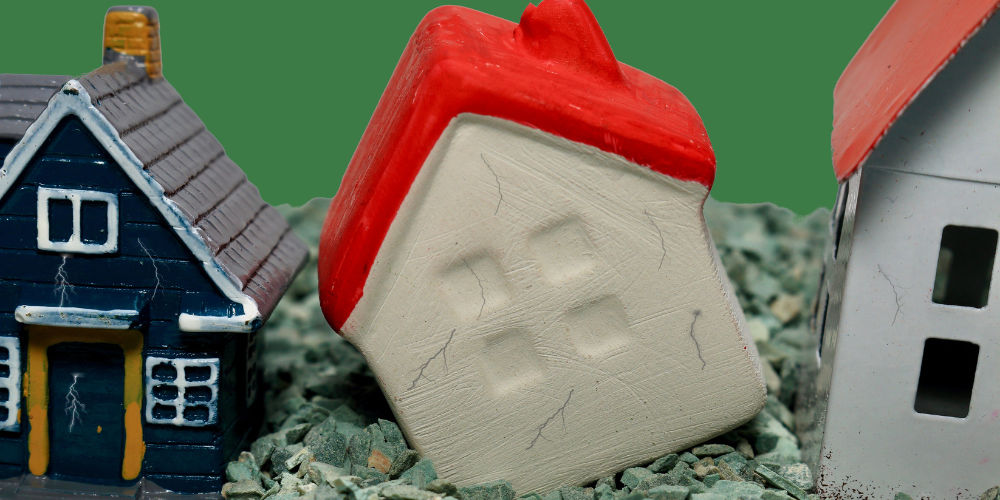Sismabonus 2026: guide to deductions for anti-seismic interventions. Find out how it works, transfer and extension.
The Sismabonus 2026 is a tax incentive on anti-seismic adaptation works to improve the characteristics of a certain property (with respect to seismic risk). This tax relief is provided by the Italian government following the earthquakes of recent years.
The sismabonus incentive (tax deduction on expenses for anti-seismic works) provides for an amount that varies depending on the geographical area (depending on the earthquake risk) and the type of intervention carried out.
I am
Elia Caneppele and today I am writing this guide on the
anti-seismic bonus with the aim of helping all those who wish to
secure their home from earthquake shocks.
The objective of the
Earthquake Bonus is precisely to increase investments in
earthquake renovation work on the building heritage already present in our territory.
The extension of the sismabonus has been extended until 2027 , but with some limitations and overlaps with the regulations currently in force. The new provisions, included in the budget bill for 2025, concern both interventions for the seismic safety of buildings and the purchase of properties already compliant with seismic standards.
The extension of the 2025 earthquake bonus overlaps with the Superbonus , which will remain valid for works started by 15 October 2024. The latter will be in force until 31 December 2025, but with a reduced rate of 65%.
Decreasing Earthquake Bonus: Rates and News from 2025 to 2027
The earthquake bonus will undergo a progressive reduction in rates in the three-year period 2025-2027, with differences based on the type of property. In particular:
Earthquake Bonus 2025:
- 50% for interventions on first homes.
- 36% for interventions on homes other than first homes and non-residential properties.
Sismabonus 2026 and Sismabonus 2027:
- 36% for first homes.
- 0% for homes other than first homes and other categories of properties.
New spending caps for Sismabonus 2025
From 2025
, the spending limit of 96,000 euros will be confirmed for taxpayers with a total income of up to 75,000 euros. However, for those who exceed this threshold, the amount of the deductions will be "personalized".
Another article of the Budget Law introduces a
calculation system that takes into account the number of dependent children and the presence of children with disabilities . This mechanism, while respecting the specific limits of the individual benefits, provides for a further modulation of the deductions for higher incomes.
Sismabonus: how does it work? What is it and what does it depend on?
The Sismabonus is the
incentive for interventions to adopt anti-seismic measures (art. 16, 1-bis, Legislative Decree 63/2013).
The Sisma Bonus is possible with the
Irpef or Ires deduction for taxpayers (private individuals and companies) and is intended to encourage work that makes homes and productive buildings safe.
As we will see in more detail, these works must be carried out on buildings located in
high-risk seismic zones (zones 1 and 2) and in zone 3 (zone 4 is excluded).
The deduction is calculated on a maximum of 96 thousand euros per real estate unit and must be divided into 5 equal annual installments.
The
Sismabonus 2022 and
Sismabonus 2023, Sismabonus 2024 have passed, but until 2027
the Sisma Bonus interventions are extended by the 2024 Budget Law.

Earthquake Bonus Deduction and Earthquake Bonus Incentives
- Benefit name: Sismabonus (tax deduction);
- Beneficiaries: natural persons (IRPEF) and legal entities (IRES);
- Properties involved: homes (including second homes) and productive activities;
- Deductible expenses: anti-seismic structural interventions and related works;
- Maximum amount: €96,000 per real estate unit in 5 years.
The Sismabonus takes concrete form thanks to the possibility, given to individuals and companies, to deduct from their income a portion of the expenses for anti-seismic works on buildings located in seismic zones 1, 2 or 3 .
The earthquake bonus is calculated only on
existing buildings , not on new buildings or extensions.
To calculate the
seismic bonus incentives, the law indicates 8 classes of seismic risk: A+, A, B, C, D, E, F, and G. Buildings in class G are in the conditions of maximum risk. Instead, buildings in class A+ are at lower risk.
The
earthquake bonus deduction provides for a percentage that varies:
- 50% if no seismic risk class is lost.
- 70% if you go down one class in the property certificate;
- 80% if you go down two risk classes;
- 75% for condominium works that reduce by one class and requalify from an energy point of view (Ecosismabonus).
- 85% works on condominium parts that reduce by two classes and at the same time requalify from an energy point of view.
Ceiling and maximum limit of deductible expenditure for earthquake bonus interventions
A
maximum of 96,000 euros can be deducted for each real estate unit.
The expenditure for earthquake bonus interventions will be repaid in 5 years, including the year in which it was incurred.
What is the Sismabonus?
The SIsmabonus is a tax deduction (IRPEF or IRES) that
is available to individuals or companies .
The earthquake bonus interventions are carried out on residential properties (including second homes) or dedicated to productive activities. The important thing is that the buildings are located in seismic zones 1,2,3.
Owners and holders of a right of enjoyment, loanee, tenant, cohabiting family member or future buyer benefit from the Sismabonus. Continue reading: later we will see in detail all the beneficiaries who can request the sisma bonus interventions.
Example of earthquake bonus incentive
Let's say we want to secure a small house. We spend €70,000 and reduce the seismic risk by 1 class.
The Revenue Agency will return 70% of the expense incurred in IRPEF deductions, or in IRES deductions. The Agency will not pay €49,000 (65% of €70,000) into the account, but will return the sum by deducting it from future taxes, in five annual installments.
Super Earthquake Bonus 110%
Once the conditions set by the Superbonus are met, the benefit increases to 110% and is called
Super Sismabonus .
: this means that if all the conditions set by the Superbonus are met, there is an obligation to apply 110% and it is not possible to choose to apply the rates of the (certainly less complex) ordinary Sismabonus.
The 50-70-75-80-85% rates are still in force after July 1, 2020 (and until December 31, 2024). Therefore, if the Superbonus criteria are not met, the ordinary Sismabonus rates continue to apply.
With the 2020 Relaunch Decree, the possibility of credit transfer and invoice discount was born also for Sismabonus 110 (as for all other interventions eligible for the
Ecobonus 65%, the
Renovation Bonus 50% and the Superbonus 110%).

What are the seismic hazard zones in Italy?
The
seismic classification of Italy indicates four zones of decreasing seismic danger. Each danger zone is given a value of the seismic action to be taken into account during the design phase.
- Zone 1: most dangerous area, high earthquake probability;
- Zone 2: area where strong earthquakes are possible;
- Zone 3: strong earthquakes less likely than zones 1 and 2;
- Zone 4: least dangerous zone, very low probability.
Map of natural risks in Italy
Istat and Casa Italia, Department of the Presidency of the Council, have put online an update of the integrated information framework of the
map of natural risks in Italy .
How at risk is the municipality in question? These natural dangers and risks need to be considered:
- characteristics of the territory;
- seismic, hydrogeological and volcanic risk;
- condition of buildings;
- number of cultural assets;
- demographic contextual indicators.
The
Istat Mappa dei Rischi website indicates the risks of exposure to earthquakes, floods, volcanic eruptions and landslides, thanks to the integration of data from various institutional sources. The aim is to provide a vision of exposure to natural risks.

How to take advantage of tax deductions for anti-seismic interventions ?
The subjects who bear the expenses can choose, instead of the direct use of the deduction, alternatively:
- Discount on invoice : discount on the amount due advanced by the supplier of the interventions and recovered by them in the form of a tax credit (with the option of subsequent transfer of the credit);
- Credit transfer: for the transformation of the corresponding amount into a tax credit, with the option of subsequent transfer to other entities including credit institutions and other intermediaries.
Earthquake bonus: what are the deductible expenses?
ATTENTION: the costs eligible for the Sismabonus also include the costs for the classification and seismic verification of buildings.
In fact, among the
deductible expenses for the anti-seismic bonus we have:
- professional fees for classifying and seismic checking the property;
- provision of services;
- supply of goods under the procurement contract;
- administrative fees, stamp duty and urbanisation charges.
To take advantage of the deductions of the earthquake bonus incentives you will have to pay via a specific
speaking bank transfer , from which it results:
- reason for payment;
- tax code of the beneficiary of the deduction;
- VAT number or tax code of the person making the transfer.
Who can deduct with Sismabonus?
Among the subjects who can deduct thanks to the earthquake bonus incentives we have:
- owners or naked owners;
- holders of a real right of enjoyment (usufruct, use, habitation or surface);
- renters or borrowers;
- members of divided and undivided cooperatives;
- individual entrepreneurs for properties used for production activities;
- simple partnerships, general partnerships, limited partnerships, family businesses;
- cohabiting family member;
- separated spouse assigned the property registered to the other spouse;
- member of the civil union
- cohabiting more uxorio.
What documents should I keep for the Earthquake bonus?
These are the documents you will need to keep in case of potential checks:
- preliminary ASL notification;
- Scia or Building Permit;
- speaking transfers;
- invoices or receipts;
- receipts for urbanization charges or permit fees;
- copy of the certification of the starting risk class of the building and the class reached after the project,
If you have any doubts you can read other articles about
bonuses or comment below.
I hope this guide is helpful to you.




